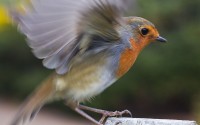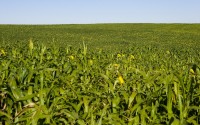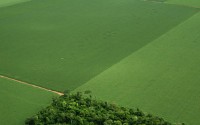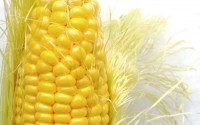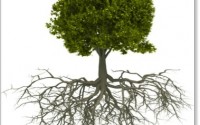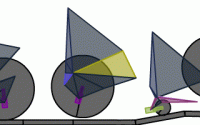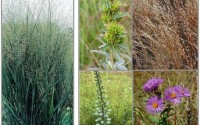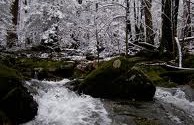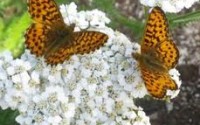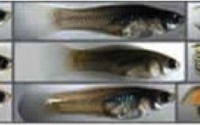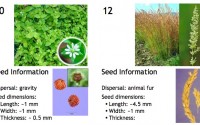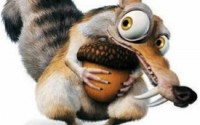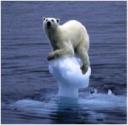Many breakfast cereals are fortified with iron, which is essential for transport of oxygen in blood throughout human bodies. The iron is simply sprayed on the cereal and can be separated by physical processes. Students in this lesson use bar magnets to extract iron from crushed up breakfast cereals. Five different cereals are used for the experiment including those with different iron concentrations based on nutritional information. Iron extracted from each cereal type is weighed and compared to the other cereals and the nutritional information on the box. At the conclusion of this lesson, students will be able to: Extract iron from fortified breakfast cereal Conduct an experiment to determine which cereals have the most iron Separate a mixture of cereal and water into magnetic and non-magnetic categories Resources: Lesson Plan Lesson created by Brook Wilke
How Do Birds Fly?
Photo Credit: Paul Tomlin The ability to fly is a fascinating biological phenomenon. In this short activity, students will identify characteristics of birds that allow them to fly, and how these characteristics are different from other animals that cannot fly.Many of these characteristics are listed in this lesson for teacher use, including how bird wings are arc shaped, causing decreased air pressure above the wing compared to below.Students also will learn that not all birds are able to fly. At the conclusion of this lesson, students will be able to: Understand that gravity is a force that pulls objects toward the center of the Earth Understand that not every bird can fly Explain several reasons for why birds are able to fly and many other animals can not fly Resources: Lesson Plan Bird and squirrel picture Lesson created by Brook […]
History and Diversity of American Crops
In this activity, students explore the world of crop history in North America. They begin by choosing a crop species that was historically grown in the Americas, studying the history and ordering bulk amounts of seeds from an heirloom variety that has been around for many years. The students use the bulk seed to run a small- scale seed store where they repackage and sell seed for a profit. Students also examine the characteristics of the seed and use the schoolyard or classroom as a place to plant and examine the growth of the variety they have chosen. Plants may be maintained in the schoolyard or at students homes so that they can save seed to create a seed bank at the school. At the conclusion of this lesson, students will be able to: Provide a detailed history about a […]
Hairy Leaves
Plants have small hairs on their leaves and stems called trichomes.These structures are important for defense from herbivory and protection from cold, heat and drought. Students will investigate leaf hairs of many different plants in the schoolyard using an inquiry based activity.Two hypotheses will be made,one about whether or not all plants have leaf hairs, and whether most plants are highly pubescent (hairy) or modestly pubescent.Leaves will be collected and classified into three categories.Students will create a data table and bar graph from their data and present this to the rest of the class.The teacher will conclude with some ideas about why plants have leaf hairs and try to stimulate future questions from the students about the topic. At the conclusion of this lesson, students will be able to: Conduct a basic scientific investigation to support predictions Explain why plants […]
Habitat Loss and Fragmentation: The Good, Bad, and Ugly
Photo Credit: SUNY JCC Habitat fragmentation is visible all over Michigan. Roads, lawns, buildings, farmland, and other changes in habitat have turned our state, and most others, into a huge patchwork quilt of ecotypes. Unfortunately, the lines between those quilt squares and the small size of those patches has had a huge impact on the wildlife that call Michigan home. Come join us for a session of active games and prizes. You can really see what impacts fragmentation has by putting yourself in the shoes of the critters dealing with the changes we make. Weather permitting we will head outside for some fun, so come dressed for the chill in the air and be prepared to get active and have fun! At the conclusion of this lesson, students will be able to: Explain how habitat fragmentation can influence the survival […]
Food Chain
Students learn about a specific food chain (coyote-squirrel-acorn in this example, but can be any local food chain) in nature and that organisms can be classified as producers, herbivores or carnivores depending on their diet. A game will be played where students take on the role of different organisms in the food chain and act out different cycles.Experimental situations are played out in the game and are designed to help the students understand that there are more organisms lower than higher in the food chain.They will also learn the consequences of separately removing carnivores and plants from the food chain. At the conclusion of this lesson, students will be able to: Understand that energy flows naturally through a locally occurring food chain Define the terms producer, herbivore and carnivore Understand that there must be more individuals at the […]
All About Corn
Photo Credit: Darwin Bell Corn and soybeans cover 6% of the total land area in the United States and are grown on 15 times as much land as all fruits and vegetables combined.In this activity, students will take a walk out into a corn field to become more acquainted with this crop that is so common.Students will make calculations for the number of plants and ears of corn per acre and then estimate the total number of ears grown in the U.S.in 2002 based on USDA data.Students will be informed about the different types of corn available and that most of it is actually used for products other than human food. Finally, corn is a crop that requires high amounts of energy and nutrients to grow successfully, making it a crop that can potentially contribute to environmental pollution if managed […]
Where does plant mass come from?
Photo Credit: Audrey from Central Pennsylvania, USA Tracing matter in the gaseous form is difficult to teach and requires carefully planned activities. Plant growth is one way to teach students that most of the mass of the plant comes from somewhere other than the soil, but mostly in carbon dioxide and hydrogen atoms from water. To identify this, students will be planting seeds indoors, weighing the dry pot, soil and seed first and then the dry pot, soil and plant later. The total mass of the soil and pot will be nearly equal before and after the experiment. Students will also measure plant height throughout the experiment. Students will be able use the data from the experiment to make graphs and conclusions, which are important concepts for upper elementary students. After discovering that most of the plant mass does not […]
Big Roots for Big Problems: Exploring the Ecosystem Services of Roots
Student will explore the idea of what ecosystem services are, focusing on the importance of plant’s root systems. A brief introduction to ecosystem services will be followed by an interactive demonstration illustrating a basic ecosystem service. Then students will have an opportunity to construct their own root systems and test out their designs to see how they fare in a heavy rain event. Finally, after conducting a month long experiment with different watering regimes, students will determine whether certain plants are more equipped to deal with drought and what makes them better. This is a highly interactive lesson that requires some preparation prior to implementation. Objectives At the conclusion of the lesson, students will be able to: Understand how healthy ecosystems provide valuable services Distinguish between four different categories of ecosystem services Understand the specific role of roots in providing […]
BoxCar2D ~ Evolving better cars: teaching evolution by natural selection through inquiry
In this lesson, students explore how the basic principles of evolution can be used to produce a better vehicle using web-based software. The program, BoxCar2D, allows the user to observe evolution in action with cars in a virtual environment and design vehicles to move over a variety of 2- dimensional landscapes. The program utilizes the basic principles of biological evolution: mutation, reproduction with recombination, and selection (moving faster and farther = higher fitness). Objectives Through guided exploration of the dynamics of digital evolution in BoxCar2D, students will gain an understanding of the following concepts: Evolution happens over generations in populations, not to an individual within its lifetime. Mutations and recombination create variation. Although much of the variation is not helpful, some of it is – this random variation allows evolution by natural selection to solve problems in novel and efficient […]
BEST Plots ~ Using student-collected data in the classroom
In the following lessons, we use questions generated for and data collected from the BEST (BioEnergy SusTainability) plots to have students make predictions, draw graphs, interpret data patterns, and support claims with evidence. Students play a fun and engaging game that helps them think about the biology involved in how plants grow or how invertebrates find food in their environment. The outcomes of the game help students make predictions. We also have four classroom activities, based on the Data Nugget model, that get students looking at real data, making graphs, and answering questions by making evidence based claims. These lessons focus on parts of the overarching scientific question for the BEST plots: “Can we grow our fuel and save our flowers and butterflies, too?” These lesson plans address the following questions: How do the kinds of plants we planted (switchgrass […]
Water in the Classroom: Lake Mixing
Ever wonder why when you dive in a lake, there is a sudden drop in temperature? Russ Stolberg’s 8th grade Earth Science students have been discussing why we observe this phenomenon in our lakes and oceans. It all has to do with density! Cold water has a higher density than warmer water, and as solar radiation continually warms the surface of our lakes it makes this separation even more pronounced. I [Jake] had the pleasure working with the students on an exciting lab simulating how waters can become layered, or stratified, and then simulate how this stratification can be broken down through natural processes. Groups of students each got to work with their own pond (a clear plastic tub), which was heated by the sun (a heat lamp) and received warm wind via a blow dryer. We started with “Winter” […]
Water and Winter: How our seasons and the properties of H2O shape life in temperate lakes
Using a simple inquiry exercise, a short presentation, readings, and discussion, you will explore how water and winter interact in temperate lakes and ponds. From the properties of solid and liquid water to the effects of biannual nutrient turnover through freezing and thawing, this lesson will highlight how winter dictates the ecology in temperate lakes. It ends with current event tie-ins that will get your students excited about ice in their daily lives. At the conclusion of the lesson, students will be able to: List the unique properties of water Hydrogen bonding Ice is less dense than water Water is most dense at 4°C Explain how turnover affects nutrients, plants and animals in a lake Explain how the density of water at certain temperatures causes turnover to happen To complete this lesson in full will take two 50-minute periods. The […]
Pollination: what’s on your flowers? Observing and quantifying pollinator visitation
Students explore mutualistic interactions by focusing on pollination. Do flowers attract specific or a variety of pollinators? Students hear a presentation on mutualism and pollination in particular, and the go outside and use actual observations and data collection to discover what types of pollinators visit flowering plants in their vicinity. The lesson is adaptable to multiple topics, grade levels, and habitats. At the conclusion of the lesson, students will be able to: Explain the major kinds of interspecific interaction Explain what pollination is and how it works Identify one or more species of local flowering plants Identify pollinators by broad or narrow group, depending on age of students Collect pollinator visitation data in a scientifically rigorous way Discuss some of the ecological factors affecting composition and abundance of pollinator communities Presentation: 20 minutes Field: 30 minutes (plus time to get […]
Effect of fish on pond invertebrate community structure
This lesson offers an introduction to aquatic invertebrates living in ponds, and a look into how the presence or absence of a top predator – fish – affects the community composition and structure. This is a lesson teachers can do at KBS if they are interested – just contact Gary Mittlebach. At the conclusion of the lesson, students will be able to: Display familiarity with techniques used to sample aquatic invertebrates Describe how predators influence prey community composition and structure Identify several major groups of aquatic invertebrates Use microscopes to examine zooplankton If classes want to come out to the KBS pond laboratory, we would suggest allowing at least a half day to spend on the facilities. This will allow time for an introduction to the history and research done at the pond lab an introduction to the study system […]
Natural Selection in the Classroom
Semester-long projects that will allow students to see evolution in action In this lesson, teachers explore potential semester to year-long evolution lessons that will enable the development of classroom lessons about evolution by natural selection. These lessons consist of long-term studies where change in populations over time is observed rather than simulated. At the conclusion of the lesson, teachers will be able to: Develop a long-term natural selection lesson for the classroom Plan for the effective measurement of traits and fitness Discuss and teach the 3 requirements for evolution by natural selection: phenotypic variation, relationship between a trait and fitness, and heritability of the trait. The lessons discussed are designed to be semester to year long, long term, experiments. The long duration is necessary in order to see a response to selection. This lesson is intended for either an Intro […]
Weeds! Tricks of the Trade
This lesson will explore how plant traits like seed dispersal (e.g., wind-dispersed, animal-dispersed, etc.), seed hardiness, and land-use history influence the assembly of weed communities following a major disturbance (e.g., construction of a BEST plot, agricultural field, or garden plot). The focus will be on volunteer species (read: weeds) most commonly found in the BEST plots across the network. The lesson begins by providing students background information on seed traits and land use legacies. After covering this information, participants will do a brief activity that involves making predictions about which plant traits make weeds made most successful. Students will spend the remaining portion of the lesson analyzing and interpreting volunteer species abundance data from the BEST plot network. At the conclusion of the lesson, students will be able to: List and describe four different plant dispersal mechanisms Describe three determinants […]
Seeds on the Run: A Model of Seed Dispersal
In the 1970’s, an influential ecological hypothesis was developed by two tropical biologists trying to explain the distribution of trees in the hyper-diverse rainforests of planet Earth. We use a deceptively simple board game as a model for students to explore how two basic concepts (dispersing far is hard, and living at high density is dangerous) can be combined to explain this baffling natural pattern. We show you how to interactively lead students through the predictions of the hypothesis, give you the tools to collect data from the game itself, and finish by graphing and discussing our board-game data. At the conclusion of the lesson, students will be able to: Explain dispersal in an ecological context including why dispersal is important and the challenges of dispersal Make predictions based on ecological concepts Understand the principles of the Janzen-Connell hypothesis Graph […]
The Double Life of A Squirrel: Seed Disperser and Predator
Because they cannot move, plants have developed a diverse range of strategies to spread their genetic material: from producing tasty fruits to entice birds and mammals to encasing seeds in structures that can be carried off by the wind. Small mammals, like squirrels and mice, can be both beneficial and destructive for plant seeds – they serve as dispersal agents, moving seeds far from parent plants and into beneficial habitats, or as predators, consuming seeds before they have had a chance to germinate. Using squirrels as a study system, we will explore importance of squirrel behavior human disturbance influencing seed dispersal. In this lesson, we discuss dispersal and predation as major forces determining the fate of a seed. We will conduct an experiment where we measure squirrel removal of seeds from a seed trap to determine their activity in a […]
Dividends from Diversity
This lesson takes the student from understanding the meaning of biodiversity to understanding how important it is in real ecosystems. Using the insects captured during the BEST Plots Invertebrate Diversity Protocol, students play Bug Bingo and have fun while recognizing differences in diversity from place to place. Then, students play the Biodiversity Stock Market, to demonstrate the importance of biodiversity and the consequences of eliminating diversity. Additionally, the game will demonstrate the many economic benefits provided by high levels of biodiversity through valuable ecosystem services. At the conclusion of the lesson, students will be able to: Understand what biodiversity means in the scientific community Recognize several insects to order Understand that diversity differs from place to place, and is declining. Understand that biodiversity has economic and social benefits Understand that high levels of biodiversity improve ecosystem productivity and stability Recognize […]
The Best Genes for the Job: Exploring genotype by environment interactions
An organism’s genetic composition plays an important role in its chances of survival, but will the same combination of genes always win? An organism, (or more specifically, a set of genes) that succeeds in one environment or season may not fare so well under different conditions. In this lesson plan, students will explore how genetics and environmental conditions can affect the survival of different organisms. This classroom activity simulates how birds with different beak sizes might have a competitive advantage depending on environment. Students will then graph their data to see how environment influences the success of different genotypes. At the conclusion of the lesson, students will be able to: Explain how survival of an organism is affected by both its genotype (nature) and its environment (nurture) Understand environmental factors that contribute to the varying success of organisms, including climate, seasonal […]
The New Farmer’s Almanac: Agriculture and Climate Change
In this lesson, students learn about the difference between climate and weather and how we expect Michigan’s climate to change. They use real data from the Kellogg Biological Station’s agricultural Long Term Ecological Research site to predict how specific crops may respond to climate change. At the conclusion of the lesson, students will be able to: Explain the difference between climate and weather Name three ways the Michigan climate is expected to change Show how some crops may improve with climate change while others decline Resources: Lesson plan Agriculture and Climate Change powerpoint Student worksheet LTER Climate Change data (Excel file) Lesson written and created by GK-12 fellows Tomomi Suwa and Anne Royer, 2012
The climate is changing…but will it change me?
This lesson takes a look at some of the ways that climate change may directly affect the life of a Michigander. It includes several opportunities for discussion about student’s observations and their connection to data. Using an internet-based weather forecasting tool for Michigan, students will complete an activity that allows them to visualize how several climatic changes will affect their lives. At the conclusion of the lesson, students will be able to: Describe three different climatic changes that scientists are predicting for Michigan Provide examples of how those changes will affect their and their families day-to-day lives Draw conclusions based on maps and simplified data (For more advanced students) Use internet tools and data to make predictions about additional climate scenarios Resources: Michigan climate change lesson plan Changing climate powerpoint Michigan climate change activity pages Internet resources Lesson written and […]
Why fly south? How climate change alters the phenology of plants and animals
The timing of recurring life cycle events for plants and animals, like flowering and migration, are largely determined by cues organisms take from the climate. Scientists who study phenology, or the timing of these natural events, are interested in how climate change, particularly rising global temperatures and unpredictable transitions between seasons, will influence the timing of phenological events. For example, what can we expect to happen to the migration timing of birds, the mating season for animals, or the flowering times in plants? Further, how might abiotic seasonal changes like melt dates for lakes and rivers respond to climate change? To answer these questions, scientists turn to long-term datasets to examine whether shifts in phenological events are occurring over extended periods of time. Long-term datasets are extremely useful because scientists can examine average trends in timing shifts over periods of […]
It’s Gettin’ Hot in Here!: Consequences of Climate Change on Flora and Fauna
While public policy on climate change continues to be debated in local and national governments, the effects of global warming are already being felt by many different plant and animal populations. Rising temperatures can directly impact plant and animal populations by causing range shifts as species are forced to move into areas with temperatures they can tolerate. In the process of shifting home ranges different species that were previously isolated from one another may come in contact, leading to new biotic interactions (whether they be predator-prey, host-parasite, or resource competitor interactions). In this lesson, students will be introduced to the basics of climate change research. Specifically, focusing on the impact climate change will have on the plant and animal populations. We will investigate a number of specific aspects that will be directly impacted through climatic changes, with a number of […]
Why is there variation in personality type? Does fishing impact the variation?
Students simulate bass populations with and without fishing pressure, gather data from the simulation, analyze it by making graphs, and draw conclusions about what maintains variation in personality type and how fishing could cause evolutionary change in personality in populations that are fished. At the conclusion of the lesson, students will be able to: List the three requirements for evolution by natural selection Phenotypic variation in a trait exists within a population The phenotypes must be heritable Some phenotypes have higher fitness than others Determine whether evolution happened in a given situation and how it happened. Explain potential ecological and evolutionary effects of not using natural resources in a sustainable manner Resources: Lesson Plan Worksheet Selection on Personality Presentation
The Hunger Games: Hiding in Plain Sight – Exploring evolution using mimicry
Evolution is one of the most fundamental concepts in biology. The process of evolution by natural selection has produced some of the most spectacular traits found in living organisms. In this lesson students will explore the concept of evolution by natural selection using mimicry as an example. Mimicry refers to a similarity between more than one species for the purpose of protection. For example, a non-poisonous species may closely resemble a poisonous species, and this resemblance protects the non-poisonous species from predators. In this session, students will play a scavenger hunt game using Easter eggs to demonstrate the benefits of mimicry and the conditions under which mimicry can evolve. At the conclusion of the lesson, students will be able to: Understand the process of evolution by natural selection and be able to identify/explain its three components Understand that populations evolve, not […]
Geeked About Beaks: Inquiry learning about survival and reproduction
In this lesson, students will learn about survival, reproduction, selection, adaptation, and evolution all while playing hands-on games and constructing their knowledge through experience. Students get to be birds and compete against their classmates to eat the most seeds. This activity demonstrates how small beaks are better at getting small seeds, whereas large beaks are better at getting large seeds. Next, students become part of a bird population with a variety of beak sizes. Depending on the weather, big, small, or medium seeds are common that year. Students observe how populations change over time based on the environment. Students explain why the population changes over time, and they also make predictions about what will happen to the population in future years. At the conclusion of the lesson, students will be able to: Describe how physical characteristics of an organism affect […]
Algal Biofuels: An Emerging Renewable Energy
In this lesson, students will explore the basic living requirements of algae (aka phytoplankton) through hands-on experience and an interactive game. We will investigate what algal biofuels are, how they are made, where they can grow, and, most importantly, why this topic should be investigated. The lesson is constructed with 2 short presentations, an optional water sampling event, identification of common phytoplankton, and a team outdoor game. At the conclusion of the lesson, students will be able to: Explain what phytoplankton are and what they “consume” Gain compound microscopy experience Identify some common phytoplankton species Explain the importance of bioenergy in contrast to fossil fuels Describe the benefits of biodiversity, and define community ecology Be excited about microorganisms Resources: Algae Biofuel Lesson Plan Phytoplankton Preview Powerpoint Phytoplankton Preview Key This lesson was created by KBS GK-12 Fellow […]
Cannibalism: Is it ever a good idea?
In this lesson, students explore how different competitive strategies will affect how well organisms survive in a population. Students will play a game simulating several strategies in different environmental conditions (including cannibalism!), collect data from the game, and use these data to draw conclusions about the success of their strategies. The results of the game can be used to discuss how kin selection may influence evolution. At the conclusion of the lesson, students will be able to: Graph their data and draw conclusions based on their results Explain how environmental conditions impact the success of different evolutionary strategies Explain how kin selection might affect evolution in a population Resources: Cannibalism Lesson Plan Accompanying Powerpoint Presentation Cannibalism Rule Sheet Cannibalism Worksheet The lesson was created by GK-12 Fellow Sara Garnett, 2012
Angry Birds: Exploring Behavioral Trade-offs
Animals have limited supplies of energy and often must choose which activities to focus on at the expense of others. In this activity students will play a game that explores the trade-off between aggression and parental behavior. In part A, students will explore the role of aggression in acquiring a territory. In part B, students will explore the trade-off between parental behavior and aggressiveness and learn there are multiple ways to be successful. At the conclusion of the lesson, students will be able to: Explain how aggression impacts an organism’s success. Explain how environmental characteristics shape the benefits of aggression. Explain the tradeoff between aggression and parental behavior. Resources: Angry-birds-lesson-plan Angry birds- strategy cards Angry Birds-offspring cards Angry-birds-student-worksheet Angry Birds-Post Questions Answer Key Lesson created by GK-12 Fellow Cara Krieg


